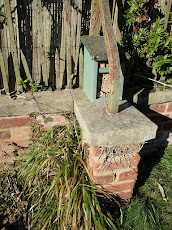Hitchin Cemetery Wildlife January to March 2022
Hitchin Cemetery Wildlife
January - March 2022
January
A quiet time of year, except if you are a bird, with Green Woodpeckers, Robins and Blackbirds busy feeding...
One of the first cemetery plants to be in flower is the Winter Aconite, looking particularly lovely in the sunlight ...
There is the occasional bug to see, with the lovely Juniper Shieldbug which overwinters as an adult and is found in the ornamental Cypress trees. A new Bee Hotel has been installed, tucked on the back wall of the cemetery, behind a bit of railing to stop it getting accidentally knocked...
February
Some high winds caused many broken branches and sadly brought down a Silver Birch tree near the chapel which was very quickly tidied away by the council.
The Winter Aconites are still flowering along with Snowdrops and there are "winding lanes" of Crocus in their thousands. Make date in your diary for next February to see them for yourself.
The low sun adds to the moodiness of the cemetery and an unusual sight was a Pheasant which convenienty perched on the boundary wall...If you fancy being part of the Freinds group, which runs under the umbrella of the Herts Countryside & Rights of Way Service, then come along one Friday (we start at 10:00) and introduce yourself.
March
Last autumn some areas were planted with native Daffodil bulbs by a party of Hitchin scouts, with support from local councillor the late Paul Clark, it is sad to report that he never got to see them flower as he unfortunately passed away in December. Hopefully in future years the daffodils will spread and multiply, and we can remember Paul when we see them.
Sometimes it is worth staring at some of the small things closely, here are some close-ups of some lichens. Lichens are formed from a fungus and algae living together in symbiosis and different lichens are specific to particular surfaces (stone, wood etc) and particular to aspect (north/south etc), there are even some which specialise in growing where bird droppings are found on the top of gravestones. If they have flat leaf-like structures they are described as "foliose" (below left) and I suspect the below right lichens are described as "crustose" but I am happy to be corrected (more research needed).
The cemetery has a large Pussy Willow aka Goat Willow and towards the end of March it comes in to flower and is a magnet for bees, so much so if you stand underneath on a sunny day and you can hear thousands of bees taking advantage of this really important food source. These bees include Honey Bees and also other solitary bee species which are particular to spring such as the Hairy Footed Flower Bee. Willows are mostly wind pollenated and don't make nectar so these bees are gorging only on pollen.
Other insects are emerging when conditions are right including Hoverflies either visiting flowers such as Anemone or basking on a stone to warm themselves up...
...and Ladybirds including some unusual ones. On the left is a 10-Spot Ladybird, and on the right a very easily overlooked Round Keeled Rhizobius which is only 3mm long, this is one of the "inconspicuous" group of Ladybirds & you can see why.
There is always something to see in the cemetery during the winter & spring months even when days are short and the weather a bit chilly.
























Comments
Post a Comment